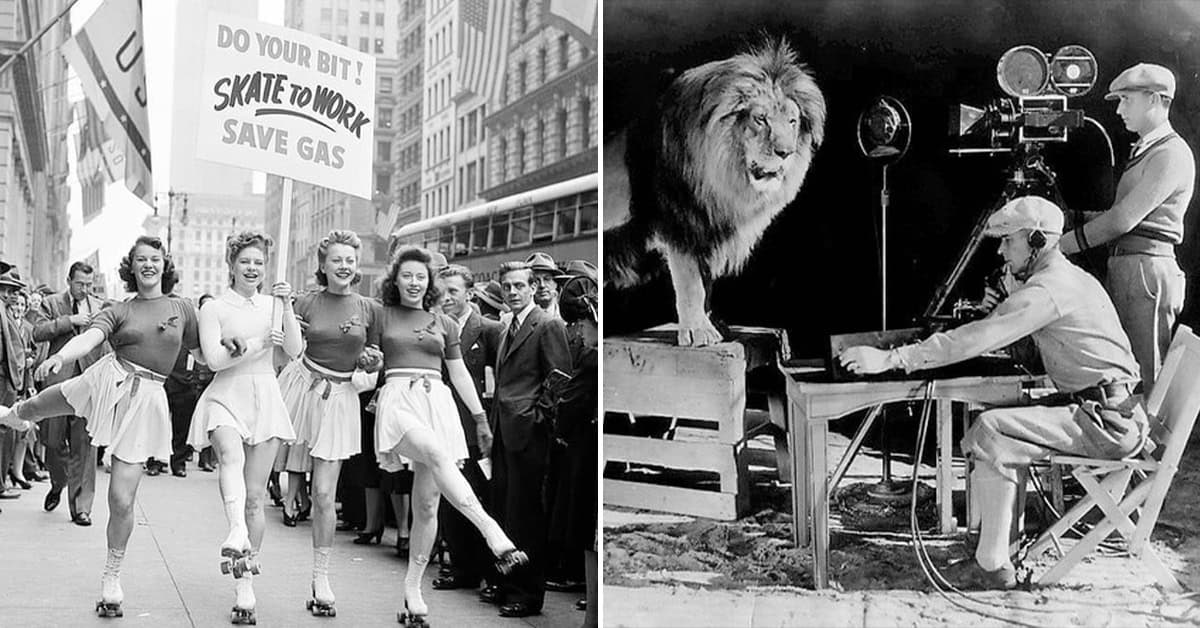30 Cool And Interesting Historical Photos With Stories You Probably Didn’t Know
History class didn’t always make it easy to care, but the internet is here to do what textbooks couldn’t: make the past actually interesting.
The Instagram account “History Cool Kids” has been sharing some of the most eye-opening, unexpected, and downright cool historical photos around. These aren’t your average black-and-white snoozefests. They’re the kind of pictures that spark curiosity, give context to significant moments, and occasionally make you say, “Wait, that happened?”
Each photo comes with a bite-sized backstory, and together, they piece together a side of history that doesn’t feel so far away.
So here are surprisingly cool snapshots from the past. You might learn something. I know I did.
1. “Sharpshooter Annie Oakley taking a shot over her shoulder using a hand mirror, circa 1899.”

“Oakley performed the daring trick during her time with Buffalo Bill’s Wild West Show. She “never failed to delight her audiences, and her feats of marksmanship were truly incredible. At 30 paces she could split a playing card held edge-on, she hit dimes tossed into the air, she shot cigarettes from her husband’s lips, and, a playing card being thrown into the air, she riddled it before it touched the ground.”
On March 19, 1884, Chief Sitting Bull was sitting in the audience when “Oakley playfully skipped on stage, lifted her rifle, and aimed the barrel at a burning candle. In one shot, she snuffed out the flame with a whizzing bullet. Sitting Bull watched her knock corks off of bottles and slice through a cigar Butler held in his teeth.”
At a time when marksmanship was dominated by men, Oakley’s confident, precise performance challenged gender expectations and elevated her to international fame.”
2. “This is how they recorded the opening lion roar of the MGM films.”
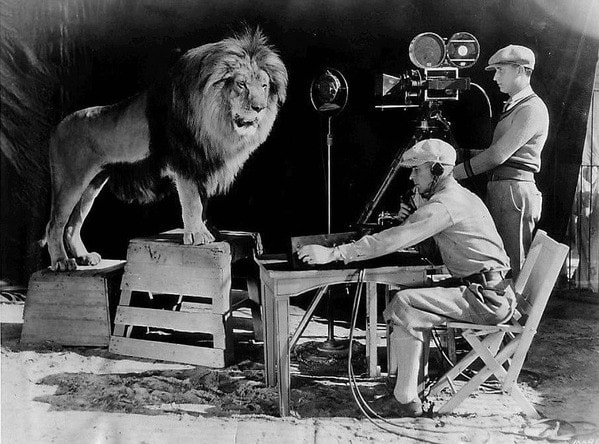
“Beginning in the silent film era, the first lion, Slats, was filmed simply turning his head without a roar. With the introduction of sound, Jackie became the first lion to roar on screen in 1928, captured using early sound recording technology. The lion was placed in front of a stylized frame resembling the MGM logo, and trainers stood just off-camera to ensure safety.
Over the years, various lions were filmed on controlled sets, often coaxed into roaring with commands or treats. The most iconic lion, Leo, introduced in 1957, remains the face of the brand, his color footage and mighty roar becoming synonymous with classic Hollywood.
Contrary to rumors, the lions were never harmed during filming, and their appearances were carefully managed by expert handlers.”
3. “Queen Elizabeth II’s wedding cake.”

“Standing an impressive 9 feet tall and weighing over 500 pounds, the cake was created for her wedding to Prince Philip on November 20, 1947. It was made by McVitie & Price Ltd, a British biscuit and cake company, and was famously dubbed the “10,000 Mile Cake” because many of its ingredients—such as flour, sugar, and dried fruits—were sent from overseas, including Australia and South Africa, as post-war Britain was still under strict rationing.
The cake had four elaborately decorated tiers, each layered with rich fruitcake and adorned with ornate royal icing. The decorations featured the coats of arms of both families, the couple’s monograms, and intricate sugarwork symbolizing British Commonwealth nations.
A 77-year-old slice of the wedding cake was recently sold at auction for £2,200 (approximately $2,800). The slice was discovered in remarkable condition—stored in its original presentation box and found tucked away in a suitcase under a bed in Scotland. Accompanying the cake was a letter from the Queen, adding personal and historical significance to the find.”
4. “Miss America, 1924.”
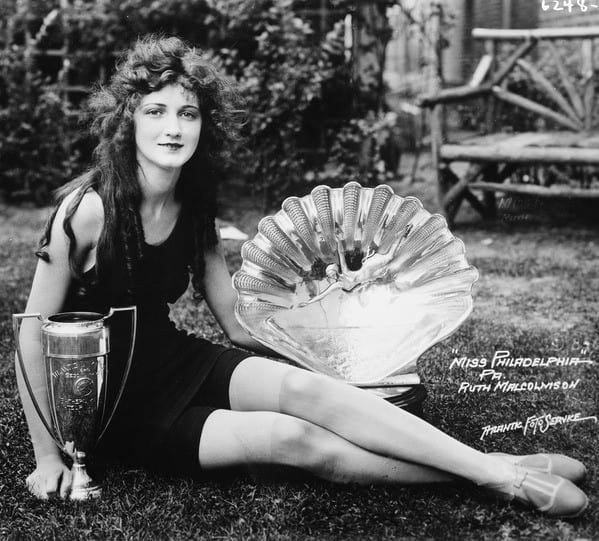
“Ruth Malcomson won the title at age 18 after winning Miss Philadelphia in 1923. Back then, the beauty pageant was called ‘The Atlantic City Pageant’ and the winner was named ‘The Golden Mermaid.’
Shortly after her win, Malcomson provided her 10 rules of beauty:
1. Rise early.
2. Eat a hearty breakfast.
3. Exercise.
4. No alcohol.
5. Smoking is detrimental.
6. Get outdoors.
7. Eat a light lunch.
8. Eat a satisfying dinner.
9. Early to bed.
10. Sleep.
No real surprises in her answer, but I thought it was interesting that she knew smoking was bad at a time when many doctors were enthusiastic smokers. A poster from 1930 even shows a doctor in a white coat with a pack of Lucky Strike, claiming that ‘20,679 physicians say Luckies are less irritating.’
As for her hair—it was intentionally unkempt as that was one of the styles that was popular during the 1920s. The pageants also took place in Atlantic City by the beach, so the humidity, wind, and salt water could have also played a role in making her curly hair stand out more.”
5. “‘Do Your Bit! Skate To Work’—women of the USO (United Service Organizations) promoting gas rationing during WWII in New York City during the 1940s.”
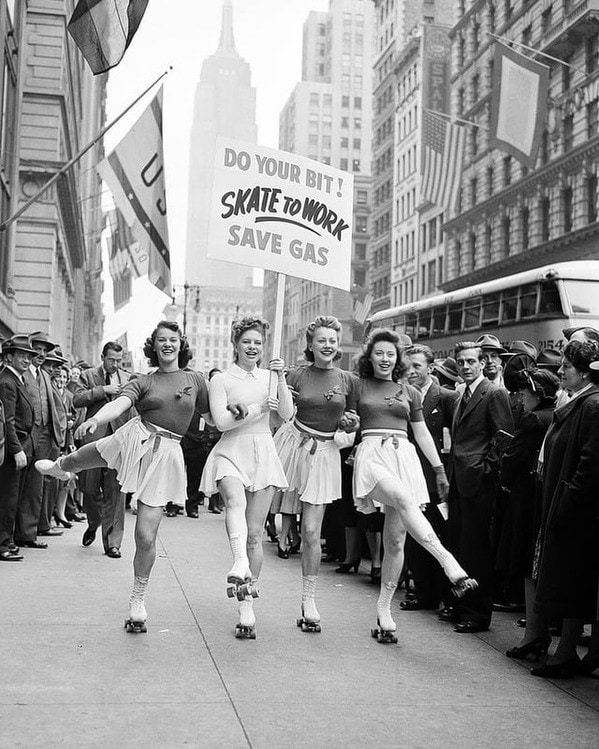
“During this time, the average price of gasoline in the United States ranged from about 18 to 27 cents per gallon, with prices remaining relatively stable throughout World War II due to strict government controls.
Adjusted for inflation, this equates to roughly $3 to $4 per gallon today. During the war, gasoline was heavily rationed to prioritize military needs, and civilians were issued ration books and stickers that limited how much fuel they could purchase.
Food items like sugar, meat, butter, coffee, canned goods, and cheese were tightly controlled, while everyday essentials such as gasoline, rubber, shoes, and nylon were also rationed due to their importance in war production. Even soap, cooking oil, and heating fuel were limited. The government encouraged citizens to stretch what they had with the motto: ‘Use it up, wear it out, make it do, or do without.’ Rationing became a shared part of life on the home front, reflecting the collective sacrifice that defined the wartime experience.”
6. “An estimated 800,000 people gathered on the Golden Gate Bridge on May 24, 1987, to celebrate its 50th anniversary.”
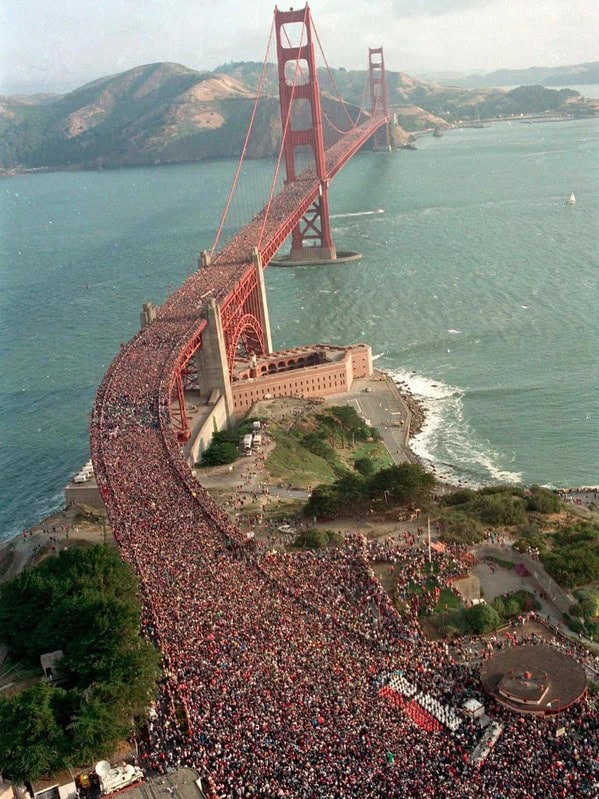
“The crowd was so dense that officials had to close the bridge and allow only pedestrians. The weight of the crowd caused the bridge’s suspension deck to flatten, eliminating the slight upward arch that normally characterizes the roadway.
All 419,000 tons groaned and swayed in the wind. While the bridge was structurally sound and did not suffer any damage, the change in shape was alarming to many pedestrians. Engineers described it as a ‘once-in-a-lifetime event,’ but stressed that there was no real danger.”
7. “HEDY LAMARR was a Hollywood actress in the 40s and 50s, and at one point was considered ‘the most beautiful woman in the world.’ Her facial features are widely believed to have inspired that of Snow White.”
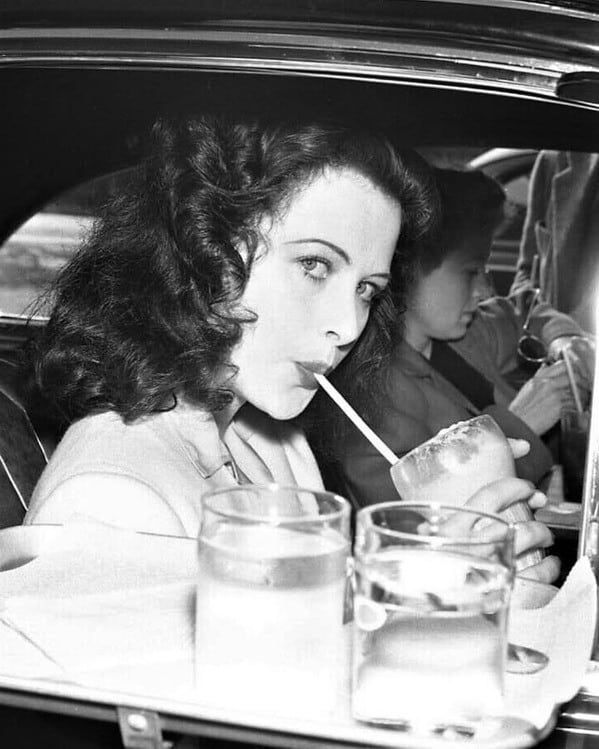
“She began her acting career in Austria and her breakout came with the controversial 1933 film Ecstasy, in which she became internationally known for her daring performance. Around the same time, she married Friedrich ‘Fritz’ Mandl, a wealthy Austrian arms manufacturer, in 1933. However, Mandl was controlling and sought to suppress her acting career, even trying to buy and destroy copies of Ecstasy. Their marriage exposed her to high-level military and technological discussions, as Mandl frequently entertained politicians and scientists. Some historians believe this experience helped fuel her later interest in military technology.
The marriage did not last long as she writes, ‘I knew very soon that I could never be an actress while I was his wife. … He was the absolute monarch in his marriage. … I was like a doll. I was like a thing, some object of art which had to be guarded—and imprisoned—having no mind, no life of its own.’ According to her autobiography she disguised herself as one of the maids and managed to flee to Paris. Others say she convinced her husband to wear all of her jewelry for a dinner party and then disappeared afterwards.
She eventually booked a liner to New York where she met the head of MGM who was impressed enough to get her a $500 a week contract to work as an actress. In 1938, she arrived in Hollywood and went on to star in several movies, working with the likes of Clark Gable and James Stewart.
Beyond her acting, Lamarr was also a scientist and went on to co-patent spread-spectrun technology during World War 2 to stop the Germans from jamming navy torpedoes. However, her invention was rejected and wouldn’t be implemented until the Cold War in 1962. The technology would eventually also be used in developing Wi-Fi and Bluetooth technology.”
8. “This is the right forearm of Michelangelo’s Moses (c. 1513–1515) statue.”
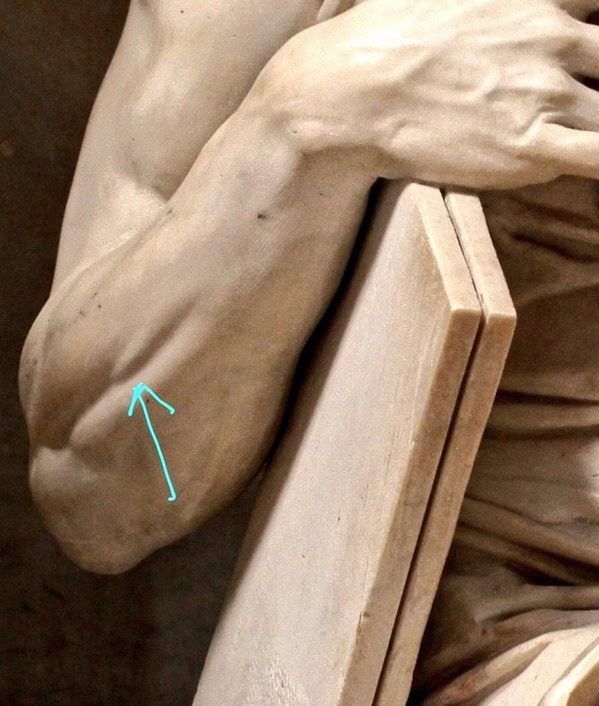
The arrow points to a small muscle called the extensor digiti minimi, which only contracts when the pinky is lifted, otherwise it is invisible.
Most of Michelangelo’s sculptures are painstakingly detailed and you can clearly see his obsession with the human body, which he saw as a physical representation of the soul. Michelangelo always preferred sculpting over painting.
And while he was extremely dedicated to his craft, Michelangelo was also human. One of my favorite letters of all time is the one in which he writes to Giovanni da Pistoia (a member of the Florentine Academy) while painting the Sistine Chapel.
“I’ve already grown a goiter from this torture,
swollen up here like a cat from Lombardy
(or anywhere where the stagnant water’s poison).
My stomach’s squashed under my chin, my beard’s
pointing at heaven, my brain’s crushed in a casket,
my breast twists like a harpy’s. My brush,
above me all the time, dribbles the paint
so my face makes a fine floor for droppings!
My haunches are grinding into my guts,
my poor ass strains to work as a counterweight,
every gesture I make is blind and aimless.
My skin hangs loose below me, my spine’s
all knotted from folding over itself,
I’m bent taut as a Syrian bow.
And because I’m like this, my thoughts
are crazy perfidious tripe:
anyone shoots badly through a crooked blowpipe.
My painting is dead.
Defend it for me, Giovanni, protect my honor.
I am not in the right place—I am not a painter.”
9. “Nona Gaprindashvili is a Georgian chess legend and one of the most groundbreaking figures in the sport’s history. “

“Born in 1941 in Zugdidi, she became the Women’s World Chess Champion in 1962 at the age of 20 and held the title until 1978. Renowned for her aggressive and confident playing style, Gaprindashvili was the first woman to be awarded the title of International Grandmaster in 1978, a distinction previously reserved for top male players at the time.
Over the decades, she competed against numerous male opponents and helped shatter gender barriers in chess. In 2021, she made headlines when she sued Netflix for defamation over a line in The Queen’s Gambit that falsely claimed she had “never faced men” in competition. The lawsuit ended in a settlement, reaffirming her place as a chess icon.”
10. “19-year-old Ava Gardner photo from MGM employment questionnaire, 1941.”

“The truth is that the only time I’m happy is when I’m doing absolutely nothing. I don’t understand people who like to work and talk about it like it was some sort of goddamn duty. Doing nothing feel like floating on warm water to me. Delightful, perfect.”
11. “This is Isidor and Ida Straus who were the co-owners of Macy’s department store.”
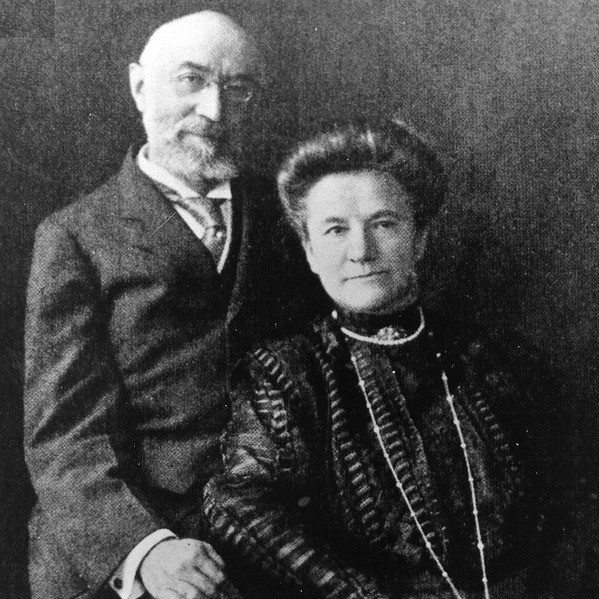
“Isidor, Ida, and their maid, Ellen Bird (it was her first week on the job) were all offered seats on Lifeboat No. 8, however, Isidor refused to get onboard because there were still women and children on the sinking Titanic.
He urged his wife to stay on the lifeboat, but Ida refused, saying, “I will not be separated from my husband. As we have lived so will we die together.”
Ida then handed her fur coat to Bird, telling her that she would not be needing it, and ordered her to get on the lifeboat. The couple was last seen on the deck, standing arm in arm.
After Bird was rescued, she tried to give the fur coat to Sara Straus Hess, the eldest daughter. Sara refused, saying her mother would have wanted Bird to keep it.
In the 1997 Titanic film, the couple lying on the bed and holding hands is based on Ida and Isidor.”
12. “French knife grinders were called ventres jaunes (‘yellow bellies’ in English) because of the yellow dust that would be released from the grinding wheel.”
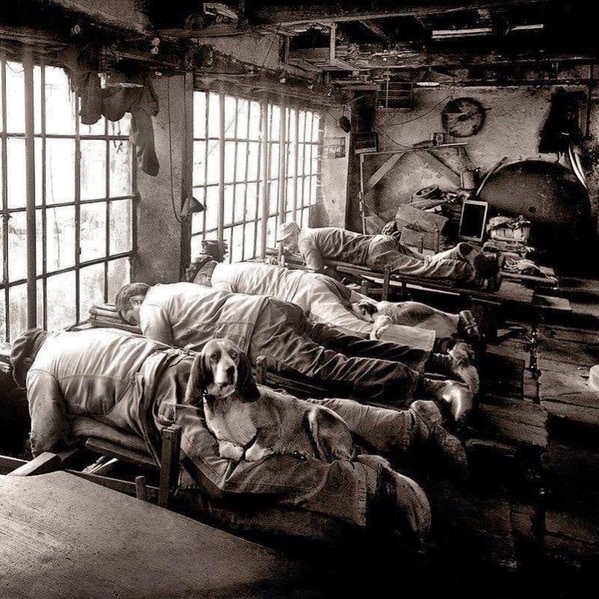
“This photo from 1902 shows the workers on their stomachs in order to save their backs from being hunched all day. They were also encouraged to bring their dogs to work to keep them company and also act as mini heaters by having them rest on their owners’ legs. “
13. “Waterproof cigs, 1941.”
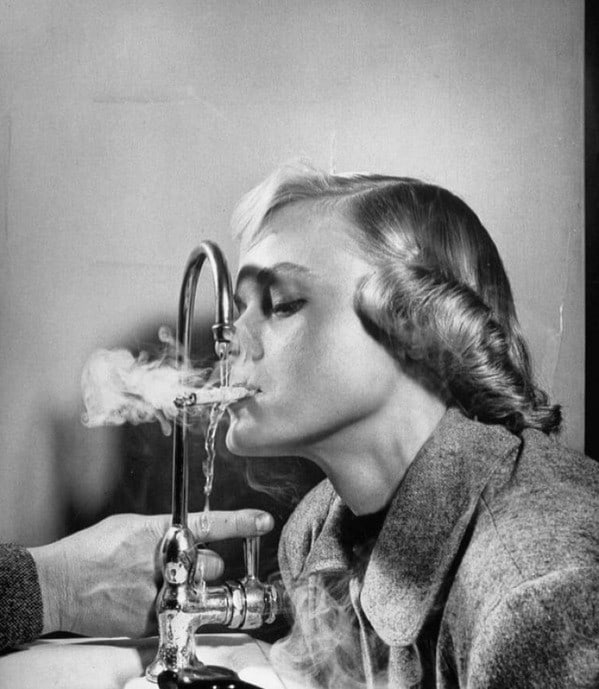
“Inventor Allen M. Bond Jr. filed a patent for a ‘wet-proof’ cigarette paper designed to solve the problem of cigarettes becoming unusable in damp or humid conditions.
The paper was treated with aluminum stearate, a compound that made it resistant to moisture without compromising its ability to burn properly. This innovation was especially valuable during World War II, when soldiers often found themselves in wet environments where traditional cigarette papers would disintegrate or stick to their lips.
The patent was granted in 1944 and reflected a broader trend of adapting consumer products for military use during wartime.”
14. “A massive LAN party in Stockholm, Sweden, 1999.”

“At the turn of the millennium, Google was just one of many search engines fighting for attention alongside Yahoo!, Lycos, and Ask Jeeves. Most households were still tethered to the internet by dial-up modems, with that unmistakable screechy sound.
Downloading a single song could take 15 minutes—if no one picked up the phone first and cut the connection. Meanwhile, Napster and LimeWire opened the floodgates to a new era of music sharing, and MP3 players—some holding as few as a dozen songs—were replacing Discmans across the country. Early 3D graphics teased us with blocky realism, and it all felt like the future.
But for many, the real magic was happening in basements, garages, and dorm rooms, where LAN parties brought gamers together in a way that was both chaotic and unforgettable. You packed up your entire computer—tower, monitor, mouse, keyboard, even speakers—into the back of a car and hauled it over to a friend’s house. Setup took hours. The room buzzed with the hum of fans and the glow of CRT monitors. Ethernet cables twisted like vines across the floor. Someone always forgot their power strip.
Games like Half-Life, Counter-Strike, StarCraft, WarCraft III, Tribes, and Unreal Tournament ruled the night. Matches were intense and winners earned bragging rights, but mostly it was about the shared experience. For a short moment in history, LAN parties brought people together to hang out, game, and socialize before technology got better and we all became more isolated… good times…”
15. “Mary Smith, a famous knocker-upper in London’s East End, uses a pea blower to launch frozen peas at her client’s window. She charged a sixpence a week.”
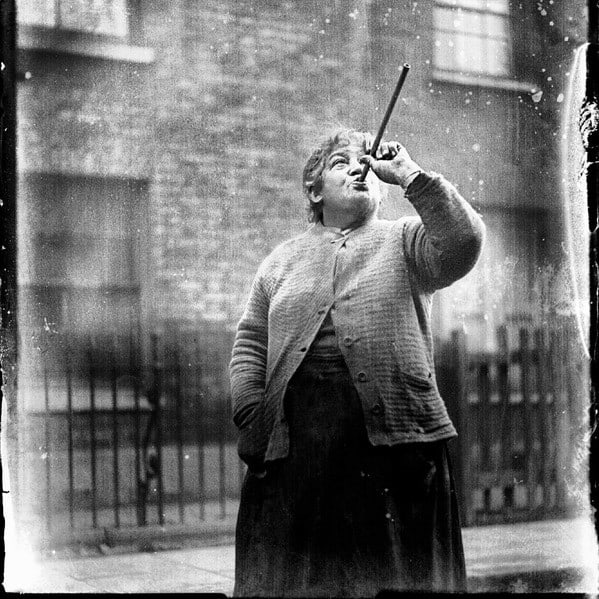
“A knocker-upper (or knocker-up) was a common profession in Britain and parts of Ireland during the Industrial Revolution and into the early 20th century, before alarm clocks were widely available or affordable. These early morning workers were hired to wake people—usually factory or dock laborers—so they wouldn’t miss their shifts.
My question is who woke up the knocker-uppers? Funny enough, I found a tongue twister from that time period that addressed this very issue:
‘We had a knocker-up, and our knocker-up had a knocker-up
And our knocker-up’s knocker-up didn’t knock our knocker up
So our knocker-up didn’t knock us up
‘Cos he’s not up.'”
16. “In the 1870s, the city of Liège in Belgium conducted an unusual experiment involving cats as mail carriers.”

“As part of a test proposed by the Belgian Society for the Elevation of the Domestic Cat, 37 cats were trained to deliver messages in small waterproof bags attached to their necks. The cats were released in villages around Liège with the goal of returning home with the mail, similar to how carrier pigeons operated.
While some cats did successfully return—one in under five hours—the overall results were inconsistent, as the cats tended to follow their own whims rather than strict delivery routes.
Due to their unreliable nature, the experiment was never repeated.”
17. “In 1953, the Marine Angel, a cargo ship measuring 634 feet (about 193 meters) in length, made its way along the Chicago River, passing beneath the Michigan Avenue Bridge.”
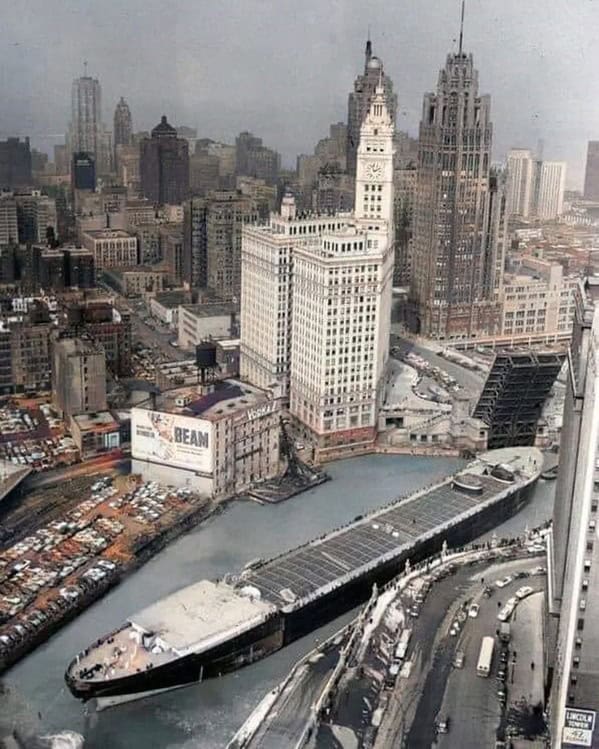
“At the time, it was the largest vessel ever to travel that route. The ship was en route to Lake Michigan to be converted into a self-unloading ore carrier for service on the Great Lakes.
Navigating such a massive vessel through downtown Chicago was a complex task. The Marine Angel had to maneuver around sharp bends and under low bridges, assisted by tugboats and experienced crews to ensure safe passage.
The Saint Lawrence seaway wouldn’t be open until 1959 and this was the only way to get a ship of this size from the eastern seaboard into the Great Lakes.”
18. “Bruce Lee’s workout routine from the 1960s.”

Squat: 3 sets of 10 reps x 95lb
French Press: 4 sets of 6 reps x 64lb
Incline Curls: 4 sets of 6 reps x 35lb
French Press: 4 reps sets of 6 x 64lb
Con Curl: 3 sets of 10 reps x 70-80lbs
Two-Handed Curl: 3 sets of 8 reps x 70-80lb
Tricep Stretch: 3 sets of 8 reps
Dumbbell Curl: 4 till Failure x 18lb
Reverse Curl: 4 sets of 6 reps x 64lb
Wrist Curl: 4 sets till Failure x 64lb
Wrist Curl: 4 sets till Failure x 10lb
Here’s also my favorite Bruce Lee quote:
“Emptiness is the starting point — in order to taste my cup of water you must first empty your cup. My friend, drop all your preconceived and fixed ideas and be neutral. Do you know why this cup is useful? Because it is empty.”
19. “Office life before the invention of AutoCAD and other drafting softwares.”
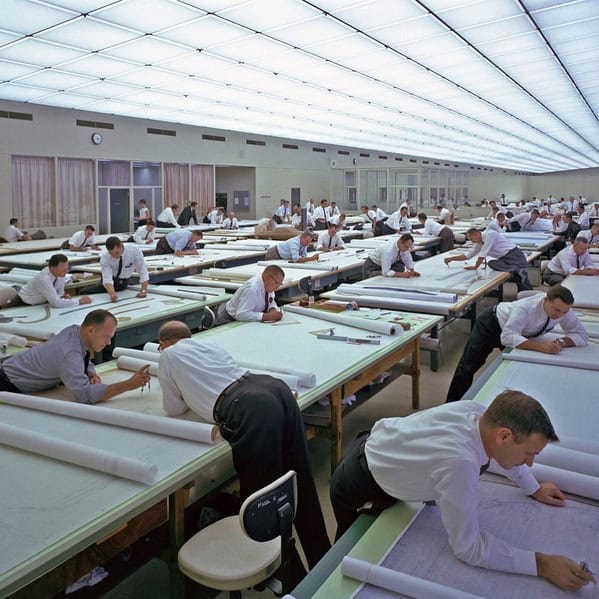
“Prior to the release of AutoCAD in 1982, engineering drawings were all done by hand using different grade pencils, erasers, T-squares and set squares.
Even after all the manual labor, if a change was required, the engineers and toolmakers had to start from scratch and make the sketches all over again. Nowadays, architecture designers and other drafters are mainly just clicking their mouse and keyboard and not hunched over on a giant desk wondering if any changes will be made to their final drafts.”
20. “The Ice Man delivering a 25 lb block of ice in Houston, Texas, 1928.”
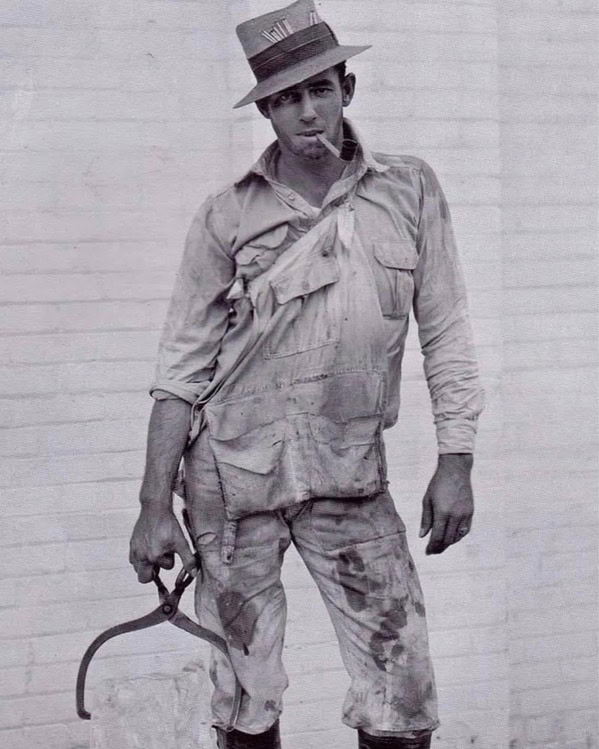
“The ice trade was a lucrative business during the 19th and early 20th century. Ice was harvested from ponds and streams and then shipped off either by railroad or ship all across the globe. A network of ice wagons would distribute the ice to its final destination.
In 1806, Frederic Tudor (aka Ice King) began the ice trade in New England by shipping it to his wealthy clients in the Caribbean. His business began to grow over the years as he expanded to Cuba and the southern part of the United States. Soon he was shipping ice all over the world to places like India, Australia, China and South America.
At the peak of the ice trade, the industry in the U.S. employed 90,000 people and 25,000 horses. The demand for ice surged during World War 1, however, once the war ended, the ice trade collapsed due to the emergence of refrigeration cooling systems. By the 1930s, modern refrigerators became more common in homes and by the 1950s, they were nearly ubiquitous in both the U.S. and Europe.”
21. “Extreme skier Doug Coombs going down a steep slope, 1989.”
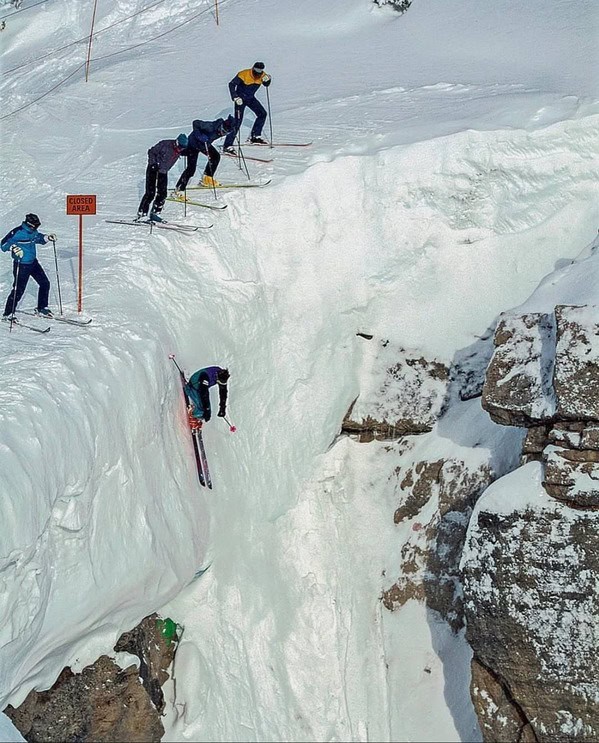
“Coombs was a skiing icon and pioneered hundreds of untested descents around the world. He was also the first winner of the World Extreme Skiing Championships in Alaska, 1991 and was considered by many to be one of the best skiers to have ever lived.
He passed away at age 48 in the French Alps while attempting to rescue his friend who had slipped into a ‘no-fall zone’ in which once you fall, you are most likely in free fall. Coombs fell more than 1,000 feet. His friend passed away in the hospital a few hours later.”
22. “Abandoned New York subway station from 1904.”
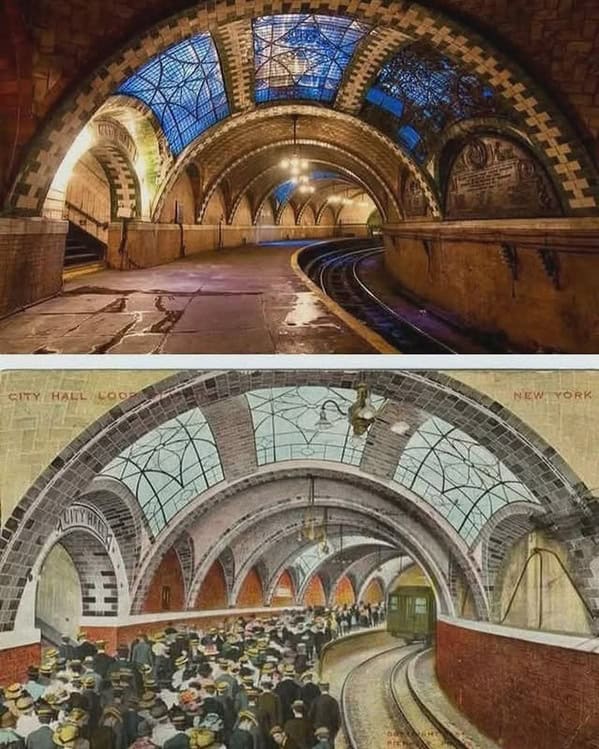
“The City Hall Subway Station in New York City was officially closed in 1945 due to its sharply curved platform—which created an unsafe gap between train cars and the platform edge. Because of its close proximity to the active Brooklyn Bridge–City Hall Station, the station is now primarily used to turn 6 trains around at the end of the line.
Despite being out of regular service, the station remains an example of early 20th-century architecture, featuring Guastavino tile arches, skylights, and vintage chandeliers. Its preserved elegance and historic significance have earned it landmark status, and it is occasionally opened to the public through very limited tours offered by the MTA and the New York Transit Museum.”
23. “Nuns checking out a fashionable woman wearing a miniskirt, 1960s.”
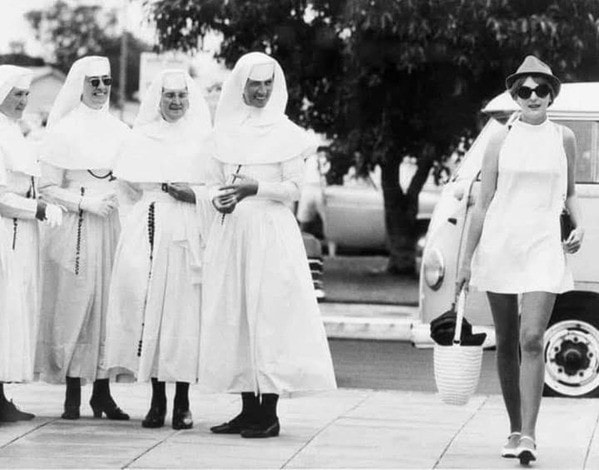
“The origin of the miniskirt can be traced to the early 1960s in London, where it emerged as part of a broader cultural shift toward youth-driven fashion and modernity. While Mary Quant is most commonly credited with inventing the miniskirt around 1963, she herself acknowledged that it was young women on the streets—particularly in London’s Chelsea district—who first began wearing shorter hemlines. She simply formalized and popularized the trend in her boutique, Bazaar.
At first I thought the nuns disapproved, but their smiles say otherwise. Just girls supporting girls!”
24. “The worn down steps of the Great Wall of China.”

“If you ever have a chance to visit the Great Wall of China, you will quickly realize that the steps are uneven and very steep, making them difficult to walk up and down. I remember having to use my hands to maintain my balance.
While time has certainly taken its toll, the stairs were deliberately designed with varying heights so that unsuspecting invaders who were unfamiliar with the wall would trip or fall, ultimately slowing them down.
Some other interesting facts that I learned about the Great Wall of China is that it is not one single wall. It is actually a series of walls with some parts in North Korea and Mongolia.
If all the walls were connected and straightened out to actually make one giant wall, it would be equal to a little over half (52.9%) of the earth’s circumference. The circumference of the earth is 40,075 km (24,901 miles) whereas the Great Wall of China is 21,196 kilometers (13,171 miles).
And contrary to popular belief, the Great Wall of China cannot be seen from space!”
25. Einstein and Oppenheimer, 1930s.

“Though I knew Einstein for two or three decades, it was only in the last decade of his life that we were close colleagues and something of friends. But I thought that it might be useful, because I am sure that it is not too soon—and for our generation perhaps almost too late—to start to dispel the clouds of myth and to see the great mountain peak that these clouds hide. As always, the myth has its charms; but the truth is far more beautiful.
Late in his life, in connection with his despair over weapons and wars, Einstein said that if he had to live it over again he would be a plumber. This was a balance of seriousness and jest that no one should now attempt to disturb. Believe me, he had no idea of what it was to be a plumber; least of all in the United States, where we have a joke that the typical behavior of this specialist is that he never brings his tools to the scene of the crisis. Einstein brought his tools to his crises; Einstein was a physicist, a natural philosopher, the greatest of our time.
Einstein is often blamed or praised or credited with these miserable bombs. It is not in my opinion true. The special theory of relativity might not have been beautiful without Einstein; but it would have been a tool for physicists, and by 1932 the experimental evidence for the inter-convertibility of matter and energy which he had predicted was overwhelming. The feasibility of doing anything with this in such a massive way was not clear until seven years later, and then almost by accident. This was not what Einstein really was after. His part was that of creating an intellectual revolution, and discovering more than any scientist of our time how profound were the errors made by men before then. He did write a letter to Roosevelt about atomic energy. I think this was in part his agony at the evil of the Nazis, in part not wanting to harm any one in any way; but I ought to report that that letter had very little effect, and that Einstein himself is really not answerable for all that came later. I believe he so understood it himself.”
-Robert Oppenheimer, 1965
26. “The tomb of Fernand Arbelot (1880–1942) in Paris’s Père Lachaise Cemetery, who wished to look at the face of his wife even in the afterlife…”
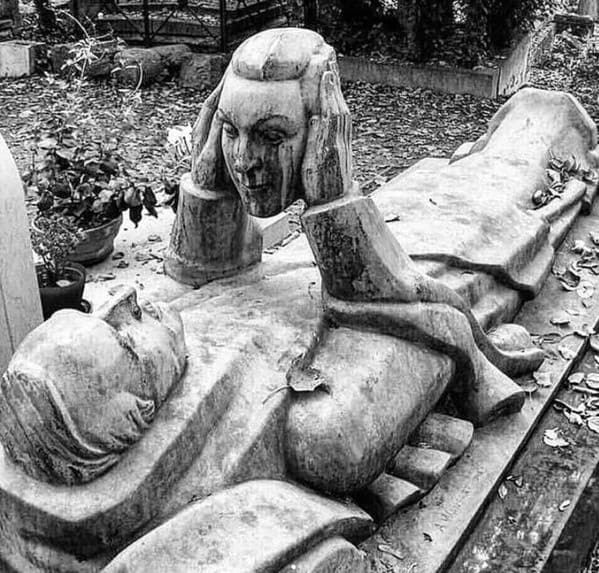
“This unique design was crafted by Belgian sculptor Adolphe Wansart, who created a bronze sculpture depicting the French actor, musician, and architect lying on his back, tenderly holding and gazing upon the face of his wife, Henriette Marie Louise Gicquel.
The epitaph on their shared tomb reads: ‘Ils furent émerveillés du beau voyage qui les mena jusqu’au bout de la vie’—translated as ‘They were amazed at the beautiful journey that led them to the end of life.’
Henriette passed away in 1967 and was interred alongside her husband.”
27. “This is Helen Hulick, a burglary witness, who caused a stir in a downtown LA courtroom by wearing slacks in 1938.”
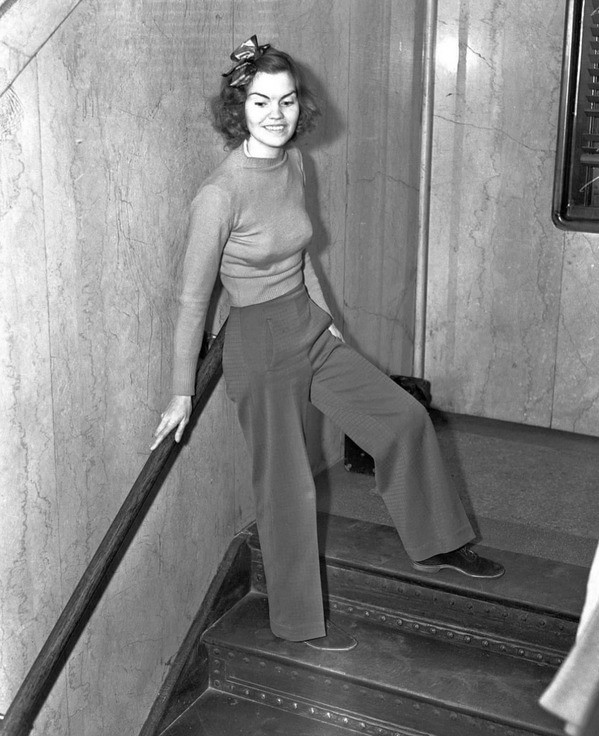
Hulick was quoted in the LA Times saying, “You tell the judge I will stand on my rights. If he orders me to change into a dress I won’t do it. I like slacks. They’re comfortable.”
She returned to court 5 days later—in slacks, which really infuriated the judge. He responded:
“The last time you were in this court dressed as you are now and reclining on your neck on the back of your chair, you drew more attention from spectators, prisoners and court attaches than the legal business at hand. You were requested to return in garb acceptable to courtroom procedure.
Today you come back dressed in pants and openly defying the court and its duties to conduct judicial proceedings in an orderly manner. It’s time a decision was reached on this matter and on the power the court has to maintain what it considers orderly conduct.
The court hereby orders and directs you to return tomorrow in accepted dress. If you insist on wearing slacks again you will be prevented from testifying because that would hinder the administration of justice. But be prepared to be punished according to law for contempt of court.”
She fired back: “Listen, I’ve worn slacks since I was 15. I don’t own a dress except a formal. If he wants me to appear in a formal gown that’s okay with me. I’ll come back in slacks and if he puts me in jail I hope it will help to free women forever of anti-slackism.”
The next day, Hulick showed up in slacks and the judge held her in contempt. She was sent to jail with a 5 day sentence.
28. “15-year-old Theodore Roosevelt Jr. and his pet Hyacinth Macau (named Eli Yale) in the White House conservatory, 1902.”
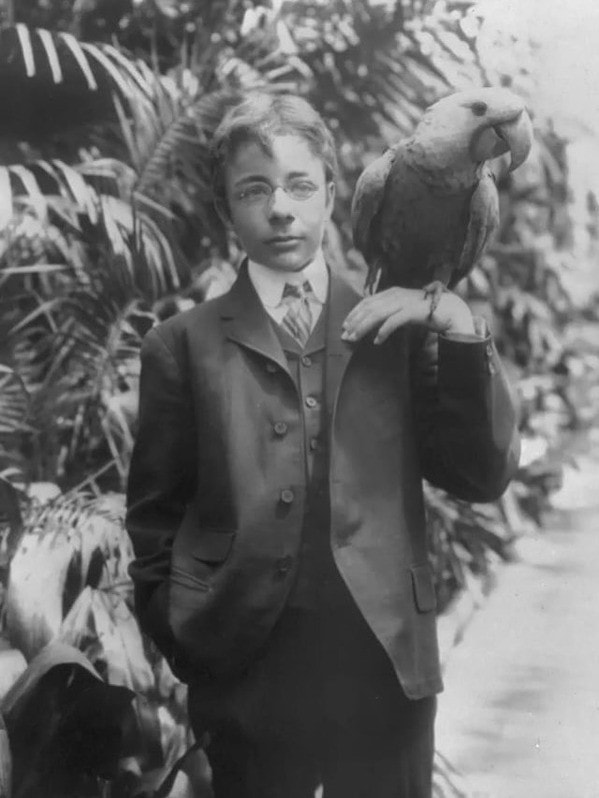
“Born in 1887 into a life of privilege, TR Jr. embraced both public service and military duty with remarkable vigor. Educated at Harvard, he served as Assistant Secretary of the Navy and later as Governor of Puerto Rico and Governor-General of the Philippines.
A veteran of both World Wars, TR Jr. is perhaps best remembered for his leadership on D-Day in 1944, when he, despite health issues (crippling arthritis), landed with the first wave at Utah Beach. He was the oldest man and only general to land by sea with the first wave of troops. When he was informed that they had not landed on the correct location on Utah beach, he famously declared, “We’ll start the war from right here.”
For his bravery, he was posthumously awarded the Medal of Honor. He passed away at the age of 56 from a heart attack just weeks later in Normandy.”
29. “28-year-old George R.R. Martin in 1976.”

“Martin grew up in Bayonne, New Jersey, a working-class city in the northeastern United States. Born on September 20, 1948, he was raised in a federal housing project with his parents and two sisters.
Bayonne, situated on a peninsula between Newark Bay and New York Harbor, shaped much of Martin’s early imagination. He has spoken about how, as a child, he could see the lights of Staten Island across the water but couldn’t afford to travel there—this sense of distance and the unattainable deeply influenced the way he thought about geography, borders, and longing in his writing. He began creating stories and fictional worlds from a young age, selling monster tales to neighborhood kids for pennies.
The themes of isolation, ambition, and unseen barriers that appear in his later work can trace their roots back to those early years in Bayonne.”
30. “200-year-old wooden bridge in Dagestan, Russia, built without the use of a single nails.”

“Located in one of the mountainous regions of the North Caucasus, this bridge is said to have been constructed entirely without the use of nails, relying instead on interlocking wooden joints, pegs, and traditional joinery techniques passed down through generations.
Such bridges were often built by local artisans using only wood sourced from nearby forests. The strength and durability of these structures come from meticulous design—where each piece is cut to fit perfectly, allowing the natural tension and weight of the components to hold the bridge together. Despite the lack of metal fasteners, these bridges were built to last, enduring harsh weather and the passage of time.”

